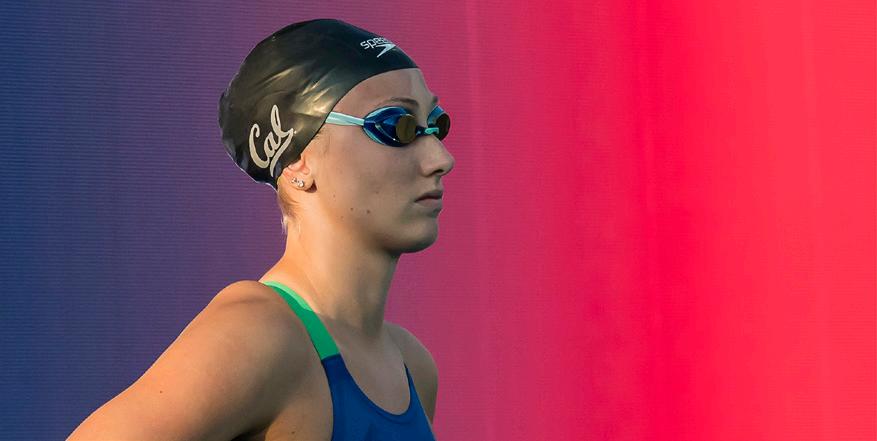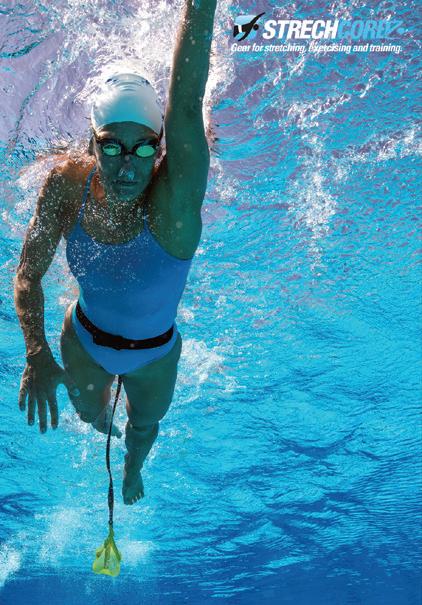
6 minute read
MENTAL PREP: BEFORE THE
BEFORE
THE BEEP
Advertisement
WITH AMY BILQUIST
BY SHOSHANNA RUTEMILLER PHOTOS BY PETER H. BICK
Amy Bilquist is tough. She has had more than her fair share keeping her nerves at bay. of struggles throughout her swimming career. Bouncing back “I want to make sure I have a really good dinner—lots of protein from a single injury is enough to make an athlete question their and veggies,” says Bilquist. “I like to fuel my body, but also include resolve—Bilquist has had to bounce back from multiple injuries. something that makes me feel happy. If I’m not getting any joy out
From three stress fractures to a broken hand to a broken foot to of my food, that’s not going to help.” knee and shoulder surgeries, Bilquist gained useful insight into the When she was younger, Bilquist would go straight for the red importance of staying both mentally healthy and mentally prepared. meat, but now she’s a big fan of chicken with a nice side salad and
“There is fortunately more attention some rice or pasta...then a little bit of “joy” that to (mental health) now because it’s been overlooked for so long,” says Bilquist. “I If there’s one message Amy comes from dessert. Back in her room, Bilquist is staying off her used to overlook it myself, but once I made Bilquist could leave young feet, watching TV and loading up on stretches it a priority, it made me both a happier and swimmers trying to find their and water. While many athletes spend the night faster swimmer. Focusing on the mental own perfect pre-race model, it’s before a big race visualizing, Bilquist conducts aspect of swimming adds another layer of potential you’ll reach.” After her broken foot, Bilquist had her most successful NCAA season as a senior at Cal. After recovering from her broken hand in 2019, Bilquist went on to win her first that a fast swimmer is having fun and is happy: “If something doesn’t go exactly according to plan from your pre-race routine, that won’t dictate if you have a most of her visualization during weights and workouts. However, she does admit to having some “super vivid” dreams the night before a big race. “My roommate at the 2016 Olympic Trials national title in the 100 backstroke. Perhaps good or a bad race. Go with the told me I made the Olympic team in my dreams this time she’ll make the Olympic team. flow, and have the confidence the night before,” says Bilquist. “Apparently, I
“All of my injuries have made me a lot you can do your best.” talk a lot in my sleep!” more intentional and grateful,” says Bilquist. “It takes a few weeks or months to grasp that WARM-UP I’m injured, but then I change my mental Bilquist’s warm-up hasn’t varied since outlook to be: ‘How can I make this help me in the long run?’” college. But you know what they say: “If it isn’t broken, don’t fix it!”
As a high schooler, Bilquist held Indiana high school records in “Before I get into the water, I am stretching and doing my the 50 free, 100 free, 200 medley relay and 200 and 400 free relays. dynamic movements like squats, squat jumps and abdominal At the 2016 Olympic Trials, she barely missed representing the exercises. I think it’s important to turn on my body before I get into United States in the 100 backstroke with a third-place finish. Now, the pool.” as one of the pioneers of professional swimming in the International A typical pre-meet warm-up for Bilquist is a 400, 300, 200, 100 Swimming League (ISL), she’s hoping that her tough mental attitude that is broken down as follows: will enable her to represent the Red White and Blue in Tokyo. Bilquist took the time to talk to Swimming World Magazine about all of the preparation, both physical and mental, that leads up • 400 swim broken into 200 freestyle, 100 25 double-arm backstroke, 100 freestyle. to a successful race. • 300 kick broken into 3x100s, 2 backstroke or freestyle kick depending on what she is racing that day, then a 100 building HOTEL up her underwater kicks followed by a 100 freestyle kicking in
The night before a big meet, Bilquist is all about fueling and various body positions.

>> With the kind of preparation Amy Bilquist puts into her race “before the beep,” this is the reaction she often has “after the beep.”
for the outcome. • 200 drill broken into 2x100s, 1 freestyle, 1 backstroke. Each 100 consists of 25 scull, 25 3 right 3 full 3 left, 25 drill...then she stops for 10 seconds at the wall before completing a 25 all-out. • 100 is broken in 4x25s doing hard pushoffs with 6 hard cycles. These 25s are either backstroke or freestyle or a mix of what the day needs in terms of quick sprints.
Additionally, if Bilquist is competing in the 200 backstroke, she will do a couple 50s in the pace lane and then a start or two off the wall.
READY ROOM
Once warm-up is done and Bilquist heads to the ready room, she’s keeping herself positive in the build-up to her race. While she’s experimented with different things in the ready room over the years, her main focus lately has been on maintaining her breathing.
“I’ve been the headphones-on/hood-up/ super-focused swimmer,” says Bilquist. “Now I like to just keep to myself and keep breathing. When you’re nervous, you tend to hold your breath.”
In addition to her breathing, Bilquist makes sure that she’s keeping to the positive self-talk, reminding herself that she’s trained for this race and is prepared




IN WATER RESISTANCE TRAINING



The ORIGINAL Resistance Swim Team Training Gear
USED BY ATHLETES WORLDWIDE
Increased stamina and speed, quicker acceleration and enhanced endurance.
BEHIND THE BLOCKS
As Bilquist heads to the blocks, she always takes a second to look up into the stands and say hi to her family. Seeing them there and feeding off the crowd’s energy is an important part of her prerace ritual. If her dad is in the stands, she looks for him to give her their “sign”—a hand over his heart.
“It’s his way of reminding me to swim with your heart and dig deep.”
Once she shakes off her parka and takes off her tennis shoes, she’s up and moving her body again. The crowd might see her slapping her body, jumping around and taking those deep, cleaning, lung-opening breaths. She’ll take a moment to look up and down the pool for the lengths that she’s swimming, always reminding herself that she’s ready for this race.
“This is the time where I get the most fidgety. I’m probably messing with my goggles trying to get the perfect seal.”
But once she’s in the water, it’s all business. She likes to follow the tried-and-true model of sticking to the race you know, but racing when the time comes.
“I stay close during the race because I’m a back-half swimmer,” she says. “That’s my biggest strength even if it’s unintentional.”
Bilquist has been a fierce competitive swimmer for the past 16 years. She knows her body and her race forward and backward. But it took those 16 years to perfect.
If there’s one message she could leave young swimmers trying to find their own perfect pre-race model, it’s that a fast swimmer is having fun and is happy: “If something doesn’t go exactly according to plan from your pre-race routine, that won’t dictate if you have a good or a bad race,” she says. “Go with the flow, and have the confidence you can do your best.” v










